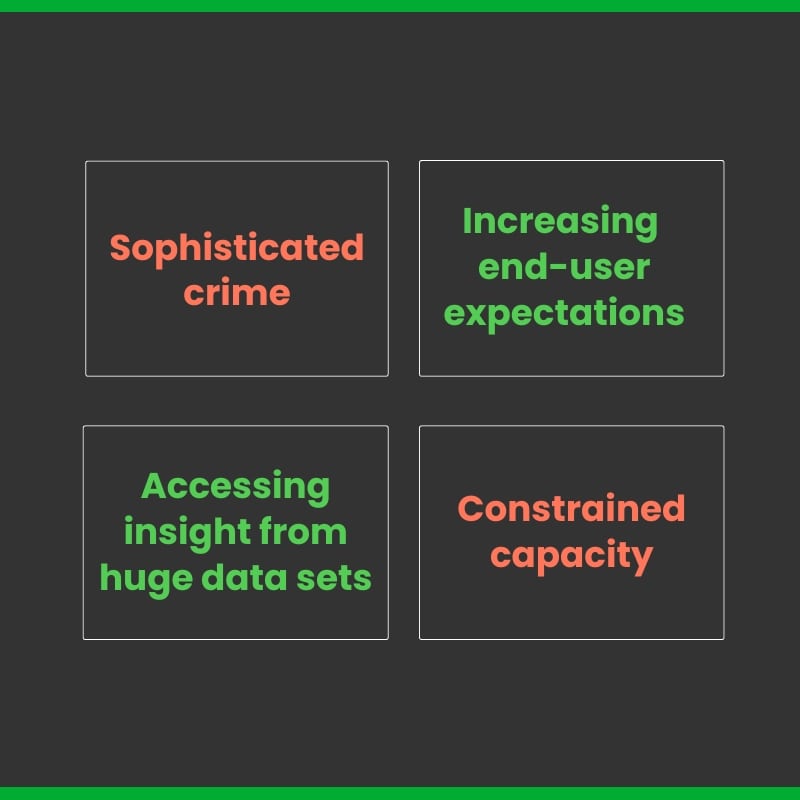The public safety sector is under immense pressure. From managing more complex service demands to sharing data across multiple agencies, the challenges are vast. Rising end-user expectations for digital products also adds to the strain. Organisations must fix all of this rapidly, despite limited resources, to ensure effective and efficient public safety services.
James West, Industry Director for Public Safety and National Security at Made Tech, gives us his views on some of the challenges and lessons he’s learnt whilst working on some recent data and digital transformation initiatives.
Q: What are some of the key challenges currently facing UK Public Safety and National Security agencies?
As you’d expect, all of the public safety organisations I talk to tell me they’re facing a relentless battle against increasingly sophisticated crime. Tactics are now multi-faceted and digital crime regularly crosses international borders. Attackers are constantly innovating. Techniques which were once easy to spot, now mimic legitimate sources making them even more likely to succeed. Cybercriminals are also taking advantage of AI and machine learning (ML) to automate tasks and personalise attacks, making crime more targeted and impactful1.
I’ve seen a noticeable shift in end-user expectations, being driven by the progress of technology and the “Netflix effect” of instant service. Citizens now expect quick, easy access to public services. Public safety organisations must match the service standards seen in consumer markets. Whether it’s tracking a reported crime or checking their passport status, people want real-time updates at their fingertips.

One of the most pressing challenges is identifying the insights from massive data sets. Public safety organisations are all inundated with large volumes of data, which create issues in terms of interoperability, data quality, insights and informed decision-making. Various sources generate vast amounts of data and manual processes with legacy systems complicate day-to-day operations, making it difficult to use information effectively.
Last but by no means least, many public safety and justice organisations are up against it when it comes to capacity and demand management. This limits their ability to fix underlying problems. Organisations are often stretched thin, with tight budgets and employee shortages. In my experience this forces people to prioritise immediate tactical investments over larger transformation initiatives.
Q: What are some of the lessons you’ve learnt when tackling the challenges in public safety?
1. Expose the problem
‘Numb pain’ is something I come across regularly in my advisory and delivery work with public sector organisations. It’s a silent adversary that’s often underestimated. Users live with limited technology and data investment to the point that when faced with process challenges or tech inadequacies, they often put in place ‘workarounds’ so they can continue to deliver – albeit inefficiently. In many instances these new ways of working are accepted as the norm and users become blind to the actual issue.
To get a handle on this, departments need help exploring the aspects of ‘numb pain’ within the organisation. From that point, you can then talk to stakeholders at all levels to identify the pain points that have been overlooked or covered up. Next step is to prioritise the problem resolution that will deliver the most impact and devise an accelerated action plan to tackle the issues. Gone are the days of waiting months or years for your return on investment. With the right digital partner you can perform a mega leap.
2. The key to digital transformation success is simplicity
I’ve picked up some useful skills and battle scars along the way to deal with the complexity of digital transformation in public safety services. It’s a cliché but you really should keep things simple. Even in the face of significant tech transformations or re-engineering out-of-date legacy systems, simplicity is key to making sure your tech or your new processes get adopted.
I’ve found that it’s best to first compartmentalise the information. Once I’ve understood how it’s all linked, I can build an architecture map in my mind and walk others through the journey. I’m then able to see the bigger picture and translate what’s possible in terms of transformation to the business.
3. Discover how to use technology as your capacity multiplier
I often hear clients call out capacity constraints as the root of many of their persistent problems. But capacity should really be about maximising the impact of the invaluable people you have working at any given time. I often see technology and data projects approached with initial scepticism, but we really are in an era where tools like automation, data and AI provide the opportunity to stretch your capacity.
It may sound obvious – but one way to do this is to simply observe and record the repeatability of tasks performed. Or identify the multiple requests for updates or information in respect of the same topic. Using technology and data points to deliver these tasks frees up valuable time and energy to address more critical issues.
Q: How can data and automation help bridge the gap between lack of resources and transformation?
The sheer volume, inadequate data management systems and fragmented information across different public safety departments exacerbates a lot of day-to-day problems. It makes it pretty much impossible in many cases to provide timely and accurate services to citizens. That being said, we still manage it in most cases. But I often challenge people at what cost? The huge volume of data that Public Safety agencies have at their disposal represents a big opportunity. This is where AI and ML can step in. Helping organisations make sense of the mountains of data and empowering people to make decisions in real-time. Arguably in the future, we’ll be able to autonomously prevent demand with intuitive citizen contact.
The power of integrated data in criminal justice
Consider the case of a prolific offender who interacts with multiple agencies within the criminal justice system. From probation services to court proceedings, each touchpoint generates valuable data that. As a whole this paints a picture of this person’s journey through the system. As a result of spotting intervention points early in this journey, agencies may be able to prevent re-offending. They can address underlying issues such as unemployment or housing instability which may have led to the initial offending. When agencies gain better access to integrated data and actionable insights, they can collaborate more effectively. This allows them to provide tailored support that makes a real difference.
Using automation to drive public safety transformation
While this vision of a single citizen view may seem daunting, the process can be broken down into manageable steps. Agencies can use automation to streamline routine activities and focus their time and effort on high-impact tasks. For example, automating searches for missing persons across multiple databases can significantly reduce response times and improve outcomes.
The journey towards public safety transformation is not without its challenges. From the dead weight of ‘numb pain’ to the constant pressure to meet high user expectations. But for those that embark into the potential unknown safely with pace, the rewards will be well worth the effort.
If you’d like to find out more about some of the services we provide to public safety and national security clients at Made Tech, check out our case studies with the Ministry of Justice and Prisoner Services or take a look at our web page.
- IBM Security. (2023, July 18). IBM X-Force Threat Intelligence Index 2023. ↩︎





